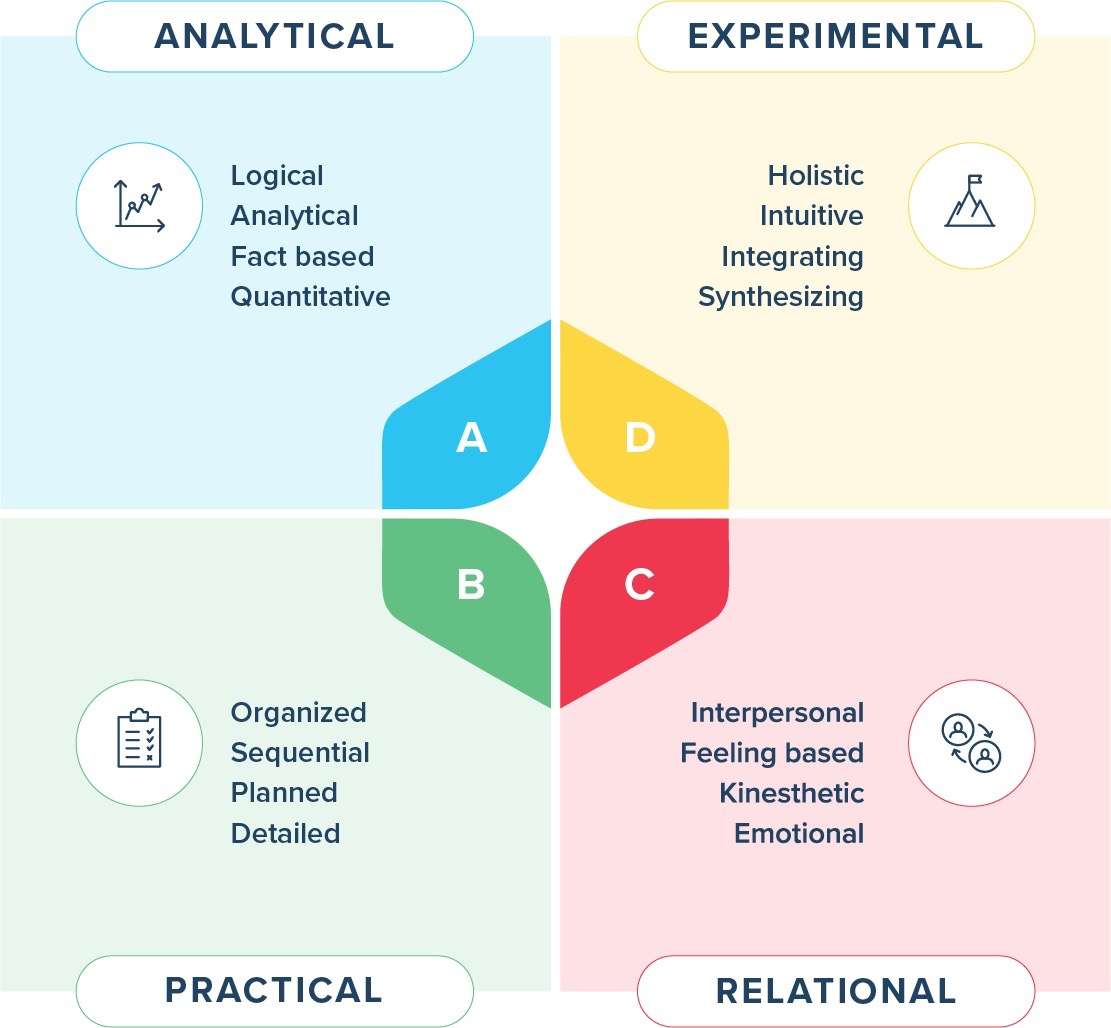Employee recognition and appreciation are the best ways to sustain engagement on your team. But not everyone wants the same kinds of appreciation. They might even dislike certain attempts at praise. This is where the five languages of appreciation can help leaders match their appreciation to each employee’s preference and need.
Unfortunately, employee appreciation of any kind is rare. Two-thirds of U.S. workers haven’t received recognition or praise in the past seven days, according to Gallup research. Employees who suffer from a lack of recognition and appreciation are twice as likely to consider quitting within the next year. Even if they don’t leave, you might struggle with quiet quitting in your workforce.
Learn more about the five languages of appreciation and how to apply them in the workplace. We’ll also explore why Whole Brain® Thinking is a powerful tool for personalizing appreciation according to each employee’s thinking preferences.
What Are the 5 Languages of Appreciation?
The five languages of appreciation are a concept created by Gary Chapman and Paul White. This concept was derived from Chapman’s five love languages for romantic relationships. In the workplace, the context changes to appreciation rather than love. The relationships are interpersonal rather than romantic, and the interactions are between co-workers or between managers and employees.
The five languages of appreciation are acts of service, quality time, words of affirmation, tangible gifts, and appropriate physical touch. Each language can be used to show appreciation in the workplace in different ways.
- Acts of service involve helping and supporting employees in practical ways. These acts include assisting with tasks, providing resources, or offering guidance.
- Quality time refers to spending dedicated and focused time with employees. This can involve one-on-one meetings, team-building activities, or meaningful conversations.
- Words of affirmation involve expressing appreciation through verbal or written communication. This can include praising employees for achievements, acknowledging effort, or providing encouragement as part of constructive feedback.
- Tangible gifts range from small gestures to large rewards. These gifts can include bonuses, gift cards, company merchandise, or experiences.
- Appropriate physical touch refers to non-intrusive forms of contact. These include handshakes, fist bumps, high-fives, and pats on the back. This approach might be unsuitable in some environments and shouldn't be used without clear communication and consent.
Leaders and organizations can use any combination of appreciation languages. Make sure these displays are fair, nondiscriminatory, and reflect how individuals prefer to be recognized at work.
.png?width=1200&height=627&name=Herrmann-InternalImage-The%205%20Languages%20of%20Appreciation%20%20(1).png)
The Benefits of Employee Appreciation
Showing workplace appreciation can yield numerous benefits for employees and organizations. One aspect of retaining talent is ensuring employees feel appreciated for their contributions and effort.
Appreciation can improve employee engagement, morale, and job satisfaction, which can reduce turnover and bolster performance. Public appreciation can also inspire teams as they see how their hard work is rewarded.
Appreciated employees are more likely to fulfill and even surpass their job responsibilities, resulting in increased productivity. When employees feel valued, they’re more loyal to their employer, which reduces turnover. Appreciated employees are also seven times more likely to feel secure in their jobs, according to Wakefield Research.
When you create a culture of appreciation, you foster a positive work environment where employees feel supported, respected, and valued. This, in turn, promotes collaboration, teamwork, and innovation, creating a positive workplace culture.

Using the 5 Languages of Appreciation with Whole Brain® Thinking
Sign up to our newsletter for the latest insights
Whole Brain® Thinking comprises four quadrants: Analytical (Blue), Practical (Green), Relational (Red), and Experimental (Yellow). Analytical thinkers are typically logical and methodical, and Practical thinkers are often pragmatic and adept at planning and organizing. Relational thinkers are emotionally attuned, collaborative, and value interpersonal relationships. Experimental thinkers, meanwhile, enjoy exploring new ideas, the big picture, and the “Why?” behind the work.
While we all prefer one or more quadrants, we can access and excel in each quadrant. And there’s no particular quadrant or combination that’s better or worse than any other.
The Herrmann Brain Dominance Instrument® is the assessment that helps us understand how we prefer to process information. The HBDI® measures analytical, practical, experimental, and relational thinking styles to determine individual preferences. It provides a blueprint for harnessing cognitive diversity to improve productivity, decision-making, and communication.
Whole Brain® Thinking provides leaders with a framework to adapt their communication and appreciation to align with the thinking preferences of their employees. Likewise, employees who share their HBDI® profiles can get a better understanding of how to show peer-to-peer appreciation.
Some thinking preferences are natural fits for certain languages — such as relational thinkers and words of affirmation. However, every thinking preference is compatible with each of the appreciation languages. Keep in mind that most people have a mix of thinking preferences, oftentimes strongly favoring two of the four quadrants.
Here are examples of how each of the five languages of appreciation can be approached through a Whole Brain lens.
Acts of Service
- Analytical thinkers: These team members might appreciate acts of service that involve providing practical solutions to streamline their work. Managers can help these employees make logical sense of complex assignments or give them opportunities to demonstrate real-world impact.
- Practical thinkers: These employees value acts of service that help them organize their work and access resources to enhance their productivity. Examples include managers who provide documentation for a project or connect employees to an experienced co-worker who can show them the ropes.
- Relational thinkers: Acts of service for these thinkers might include team-building activities or social events that strengthen team bonds. Look to emphasize interpersonal connections contributing to a harmonious and supportive work environment.
- Experimental thinkers: These employees value the ability to explore and create. An act of service might be getting the time and resources to pursue a creative project or pilot an initiative. This act of service empowers them to experiment and add value.
Quality Time
- Experimental thinkers: Employees with a strong preference for experimental thinking often thrive on innovation and problem-solving. Leaders can encourage these workers to collaborate with colleagues to fine-tune ideas or pursue a skunkworks project.
- Relational thinkers: A team member who leans toward relational thinking may highly value quality time spent together, such as team-building activities, one-on-one meetings, or social events that foster connections and strengthen relationships.
- Practical thinkers: Employees with a strong preference for practical thinking might appreciate quality time in the form of workshops or training programs that provide hands-on learning opportunities relevant to their work.
- Analytical thinkers: Quality time for analytical thinkers could take the form of managers who schedule regular check-ins to discuss complex projects, provide guidance, and engage in detailed discussions about the impact of quantitative data.
Words of Affirmation
- Relational thinkers: Individuals with a relational thinking preference may appreciate words of affirmation that acknowledge their contributions, highlight their strengths, and emphasize the positive impact they have on the team.
- Experimental thinkers: These employees often value feedback acknowledging their ability to generate new ideas, be creative, and embrace change. Words of affirmation could praise their brainstorming contributions and the impact of their ideas on the team’s thinking.
- Analytical thinkers: Employees with a strong preference for analytical thinking might appreciate words of affirmation highlighting their problem-solving skills or the tangible impact of their insights.
- Practical thinkers: These individuals might appreciate words of affirmation that recognize their efficiency, organization, and ability to get things done.
Tangible Gifts
- Practical thinkers: Practical, tangible gifts for employees with this thinking preference might include tools that help them be more organized and efficient, such as paying for productivity tools or professional development.
- Analytical thinkers: While every employee likes cash bonuses, people with a strong analytical thinking preference are especially motivated by rewards for hitting key metrics, such as sales goals.
- Relational thinkers: Employees who gravitate toward relational thinking will especially appreciate thoughtful, personal gifts. Handwritten notes, a gift certificate to their favorite store, or taking them out to lunch are just some possibilities.
- Experimental thinkers: For these employees, look for tangible gifts that spark creativity and inspire innovation. Books from leading thinkers in their field or a subscription to a creative platform are just two examples.
Appropriate Physical Touch
- Relational thinkers: People with a strong preference for interpersonal and kinesthetic thinking might appreciate appropriate physical touch in workplace moments of celebration or empathy.
- Practical thinkers: A high-five or a firm handshake can be an appropriate way to congratulate pragmatic and practical employees for their attention to detail and organization, especially when those behaviors drive business outcomes.
- Experimental thinkers: Outside-the-box thinkers might engage in a unique and fun handshake to celebrate workplace creativity and reinforce camaraderie within the team.
- Analytical thinkers: A firm handshake can express appreciation for a good job, such as acknowledging data-driven impact or achieving a revenue goal.
These are only some of the ways the five languages of appreciation can be used in workplace interactions.
.png?width=1200&height=627&name=Herrmann-InternalImage-6%20Ways%20to%20Get%20Your%20Team%20to%20Adopt%20the%205%20Languages%20of%20Appreciation%20(1).png)
Getting Your Team to Adopt the 5 Languages of Appreciation
Employees might initially resist putting the five languages of appreciation into practice. They might not understand the concepts, feel uncomfortable expressing themselves in certain ways, or be skeptical of the concept. Here are some ways team leaders can win over their employees.
Create Awareness and Understanding
Introduce the five languages of appreciation to your team members. Include examples of each in workplace settings. Help them understand why you’re implementing this approach and how to identify which languages resonate with them. If team members have HBDI® profiles, remind them how that helps them better understand each other’s thinking — just as the appreciation languages framework will help them communicate appreciation.
Encourage open conversations about appreciation preferences within your team. This dialogue will increase awareness and understanding among team members.
Assess Individual Preferences
Understanding each employee's preferred language of appreciation is crucial. Leaders can use surveys, one-on-one conversations, or observation to identify which language resonates most with each team member. Make sure employees have resources to help them understand each language.
Tailor Appreciation Efforts to Each Employee
Once the preferred language of appreciation is identified, leaders can personalize their gestures to match individual preferences. This ensures that the appreciation is meaningful and impactful for each employee. Whole Brain® Thinking can further help employees communicate appreciation effectively.
Incorporate Multiple Languages of Appreciation
While focusing on an employee's primary language of appreciation is important, incorporating other languages can further enhance the impact. Leaders can combine different languages for a comprehensive and inclusive approach to appreciation — much like how Whole Brain® Thinking helps people stretch themselves to access all four quadrants.
Lead by Example
Be intentional with your appreciation. Practice using each of the five languages of appreciation with team members. Show genuine appreciation by using their preferred language and tailoring your gestures to their individual needs.
Publicly acknowledge employees for their contributions, whether that’s during team meetings, over email, or through other channels. Leading by example reinforces the importance of appreciation and inspires others to do the same.
Encourage Feedback and Continuous Improvement
Check in with your team members periodically. See whether they feel appreciated. Make adjustments as needed, especially if anyone feels frustrated by or uncomfortable with appreciation.
Make Appreciation a Habit in Your Team
Employees who feel appreciated will perform better and are more likely to stick around. But in the busy day-to-day, too many managers can forget to offer appreciation and thanks.
The five languages of appreciation, combined with Whole Brain® Thinking, can help managers show appreciation and gratitude in lasting ways. By making appreciation a habit, you’ll improve team trust, morale, retention, and business outcomes.
Learn more about the power of workplace appreciation in creating inclusion impact.


-1.png?width=1200&name=Featured_Image_5%20Languages%20of%20Appreciation%20in%20the%20Workplace%20(1)-1.png)









